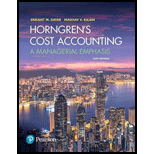
Concept explainers
Effects of differing production levels on absorption costing income: Metrics to minimize inventory buildups. Mountain Press produces textbooks for high school accounting courses. The company recently hired a new editor, Jan Green, to handle production and sales of books for an introductory accounting course. Jan’s compensation depends on the gross margin associated with sales of this book. Jan needs to decide how many copies of the books to produce. The following information is available for the fall semester of 2017:
| Estimated sales | 50,000 books |
| Beginning inventory | 0 books |
| Average selling price | $ 160 per book |
| Variable production costs | $ 100 per book |
| Fixed production costs | $750,000 per semester |
| The fixed-cost allocation rate is based on expected sales and is therefore equal to $750,000/50,000 books = $15 per book. | |
Jan has decided to produce either 50,000, 65,000, or 70,000 books.
- 1. Calculate expected gross margin if Jan produces 50,000, 65,000, or 70,000 books. (Make sure you include the production-volume variance as part of cost of goods sold.)
Required
- 2. Calculate ending inventory in units and in dollars for each production level.
- 3. Managers who are paid a bonus that is a function of gross margin may be inspired to produce a product in excess of demand to maximize their own bonus. The chapter suggested metrics to discourage managers from producing products in excess of demand. Do you think the following metrics will accomplish this objective? Show your work.
- a. Incorporate a charge of 10% of the cost of the ending inventory as an expense for evaluating the manager.
- b. Include nonfinancial measures (such as the ones recommended on page 341) when evaluating management and rewarding performance.
Trending nowThis is a popular solution!
Learn your wayIncludes step-by-step video

Chapter 9 Solutions
Horngren's Cost Accounting: A Managerial Emphasis (16th Edition)
Additional Business Textbook Solutions
Intermediate Accounting (2nd Edition)
Business Essentials (12th Edition) (What's New in Intro to Business)
Horngren's Cost Accounting: A Managerial Emphasis (16th Edition)
Foundations Of Finance
Financial Accounting, Student Value Edition (5th Edition)
Financial Accounting: Tools for Business Decision Making, 8th Edition
- General Accountingarrow_forwardApsara Beverages Co. uses process costing to account for the production of bottled sports drinks. Direct materials are added at the beginning of the process, and conversion costs are incurred uniformly throughout the process. Equivalent units have been calculated to be 21,600 units for materials and 18,000 units for conversion costs. Beginning inventory consisted of $13,500 in materials and $7,200 in conversion costs. May costs were $62,400 for materials and $72,000 for conversion costs. The ending inventory still in process was 7,000 units (100% complete for materials, 50% for conversion). The cost per equivalent unit for materials using the weighted-average method would be____.arrow_forwardHelparrow_forward
- What is its level of inventory?arrow_forwardThe Blending Department of Riverside Beverage Company had 8,500 ounces in beginning work in process inventory (85% complete). During the period, 52,300 ounces were completed. The ending work in process inventory was 3,100 ounces (75% complete). What are the total equivalent units for direct materials if materials are added at the beginning of the process?arrow_forwardWhat was its total assets turnover ratio?arrow_forward
 Principles of Cost AccountingAccountingISBN:9781305087408Author:Edward J. Vanderbeck, Maria R. MitchellPublisher:Cengage LearningPrinciples of Accounting Volume 2AccountingISBN:9781947172609Author:OpenStaxPublisher:OpenStax College
Principles of Cost AccountingAccountingISBN:9781305087408Author:Edward J. Vanderbeck, Maria R. MitchellPublisher:Cengage LearningPrinciples of Accounting Volume 2AccountingISBN:9781947172609Author:OpenStaxPublisher:OpenStax College Excel Applications for Accounting PrinciplesAccountingISBN:9781111581565Author:Gaylord N. SmithPublisher:Cengage Learning
Excel Applications for Accounting PrinciplesAccountingISBN:9781111581565Author:Gaylord N. SmithPublisher:Cengage Learning Cornerstones of Cost Management (Cornerstones Ser...AccountingISBN:9781305970663Author:Don R. Hansen, Maryanne M. MowenPublisher:Cengage Learning
Cornerstones of Cost Management (Cornerstones Ser...AccountingISBN:9781305970663Author:Don R. Hansen, Maryanne M. MowenPublisher:Cengage Learning



